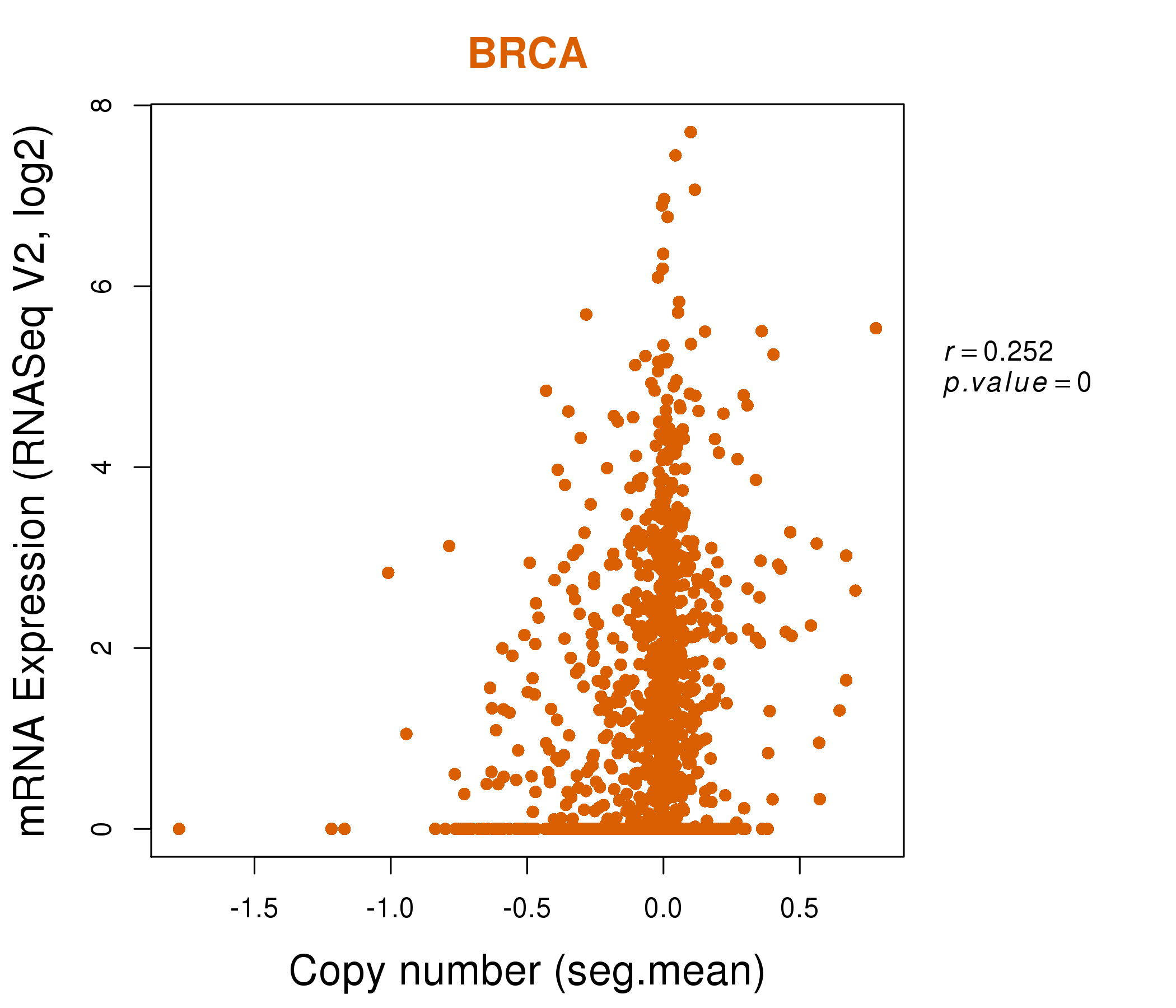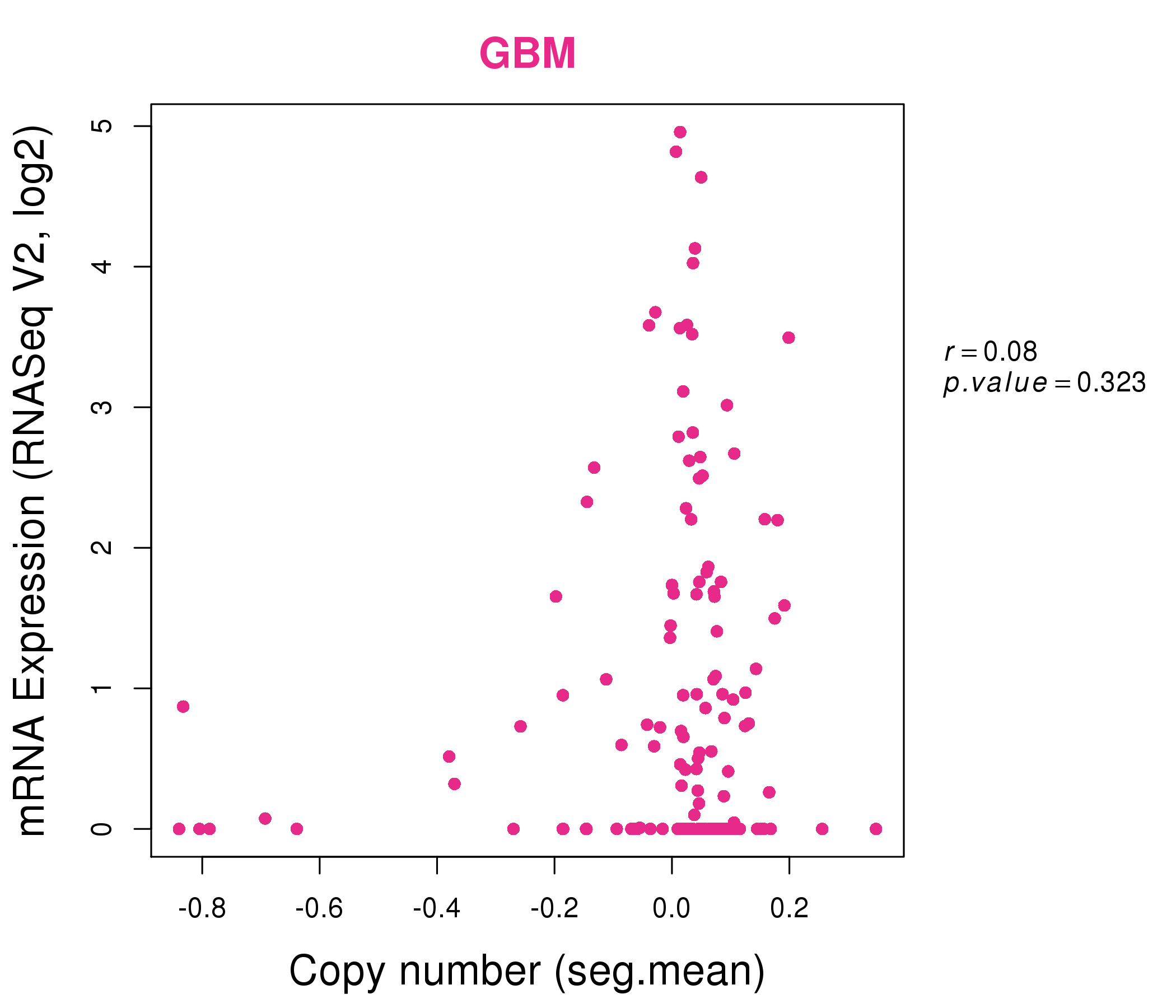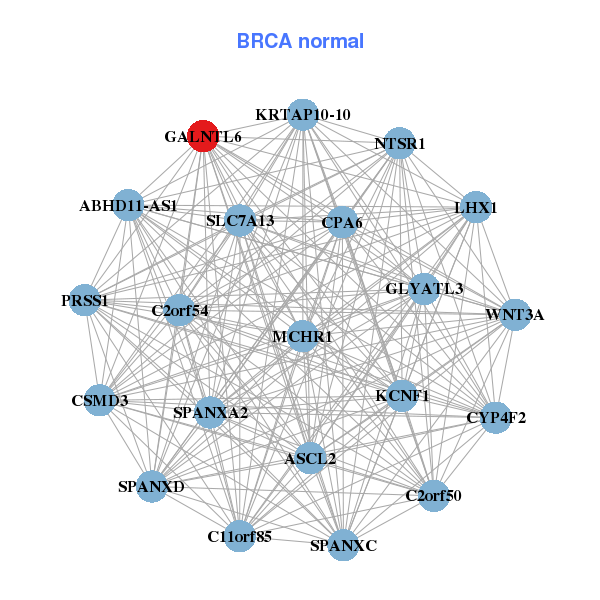|
||||||||||||||||||||||||||||||||||||||||||||||||||||||||||||||||||||||||||||||||||||||||||||||||||||||||||||||||||||||||||||||||||||||||||||||||||||||||||||||||||||||||||||||||||||||||||||||||||||||||||||||||||||||||||||||||||||||||||||||||||||||||||||||||||||||||||||||||||||||||||||||||||||||||||||||||||||||||||
| |
| Phenotypic Information (metabolism pathway, cancer, disease, phenome) |
| |
| |
| Gene-Gene Network Information: Co-Expression Network, Interacting Genes & KEGG |
| |
|
| Gene Summary for GALNTL6 |
| Basic gene info. | Gene symbol | GALNTL6 |
| Gene name | polypeptide N-acetylgalactosaminyltransferase-like 6 | |
| Synonyms | GALNACT20|GALNT17|GalNAc-T6L | |
| Cytomap | UCSC genome browser: 4q34.1 | |
| Genomic location | chr4 :172734574-173961558 | |
| Type of gene | protein-coding | |
| RefGenes | NM_001034845.2, | |
| Ensembl id | ENSG00000174473 | |
| Description | GaNTase 17GalNAc transferase 17UDP-GalNAc:polypeptide N-acetylgalactosaminyltransferase 17UDP-N-acetyl-alpha-D-galactosamine:polypeptide N-acetylgalactosaminyltransferase 20UDP-N-acetyl-alpha-D-galactosamine:polypeptide N-acetylgalactosaminyltransfera | |
| Modification date | 20141207 | |
| dbXrefs | MIM : 615138 | |
| HGNC : HGNC | ||
| Protein | UniProt: Q49A17 go to UniProt's Cross Reference DB Table | |
| Expression | CleanEX: HS_GALNTL6 | |
| BioGPS: 442117 | ||
| Gene Expression Atlas: ENSG00000174473 | ||
| The Human Protein Atlas: ENSG00000174473 | ||
| Pathway | NCI Pathway Interaction Database: GALNTL6 | |
| KEGG: GALNTL6 | ||
| REACTOME: GALNTL6 | ||
| ConsensusPathDB | ||
| Pathway Commons: GALNTL6 | ||
| Metabolism | MetaCyc: GALNTL6 | |
| HUMANCyc: GALNTL6 | ||
| Regulation | Ensembl's Regulation: ENSG00000174473 | |
| miRBase: chr4 :172,734,574-173,961,558 | ||
| TargetScan: NM_001034845 | ||
| cisRED: ENSG00000174473 | ||
| Context | iHOP: GALNTL6 | |
| cancer metabolism search in PubMed: GALNTL6 | ||
| UCL Cancer Institute: GALNTL6 | ||
| Assigned class in ccmGDB | B - This gene belongs to cancer gene. | |
| Top |
| Phenotypic Information for GALNTL6(metabolism pathway, cancer, disease, phenome) |
| Cancer | CGAP: GALNTL6 |
| Familial Cancer Database: GALNTL6 | |
| * This gene is included in those cancer gene databases. |
|
|
|
|
|
| . | ||||||||||||||||||||||||||||||||||||||||||||||||||||||||||||||||||||||||||||||||||||||||||||||||||||||||||||||||||||||||||||||||||||||||||||||||||||||||||||||||||||||||||||||||||||||||||||||||||||||||||||||||||||||||||||||||||||||||||||||||||||||||||||||||||||||||||||||||||||||||||||||||||||||||||||||||||||
Oncogene 1 | Significant driver gene in | |||||||||||||||||||||||||||||||||||||||||||||||||||||||||||||||||||||||||||||||||||||||||||||||||||||||||||||||||||||||||||||||||||||||||||||||||||||||||||||||||||||||||||||||||||||||||||||||||||||||||||||||||||||||||||||||||||||||||||||||||||||||||||||||||||||||||||||||||||||||||||||||||||||||||||||||||||||||||
| cf) number; DB name 1 Oncogene; http://nar.oxfordjournals.org/content/35/suppl_1/D721.long, 2 Tumor Suppressor gene; https://bioinfo.uth.edu/TSGene/, 3 Cancer Gene Census; http://www.nature.com/nrc/journal/v4/n3/abs/nrc1299.html, 4 CancerGenes; http://nar.oxfordjournals.org/content/35/suppl_1/D721.long, 5 Network of Cancer Gene; http://ncg.kcl.ac.uk/index.php, 1Therapeutic Vulnerabilities in Cancer; http://cbio.mskcc.org/cancergenomics/statius/ |
| REACTOME_METABOLISM_OF_PROTEINS | |
| Mutations for GALNTL6 |
| * Under tables are showing count per each tissue to give us broad intuition about tissue specific mutation patterns.You can go to the detailed page for each mutation database's web site. |
| - Statistics for Tissue and Mutation type | Top |
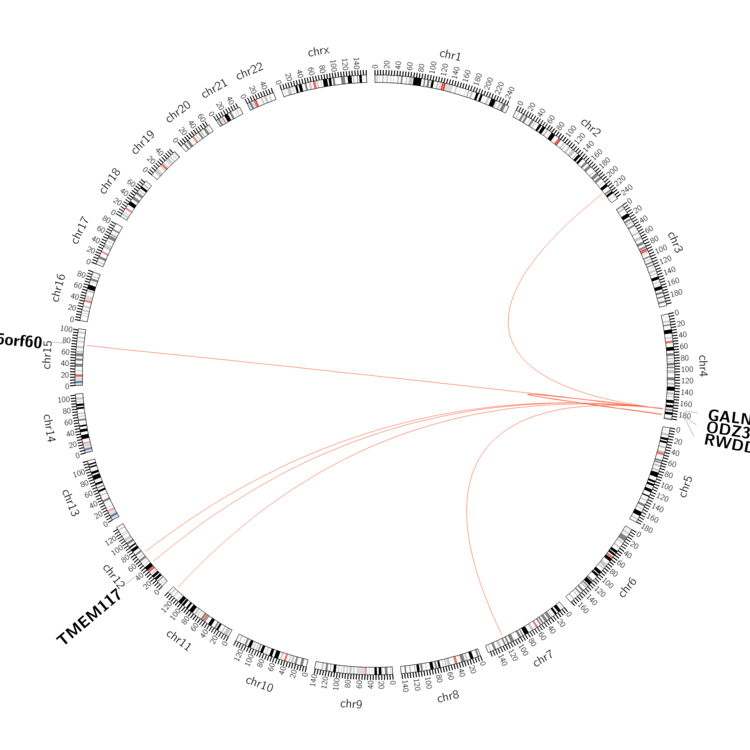 |
| - For Inter-chromosomal Variations |
| * Inter-chromosomal variantions includes 'interchromosomal amplicon to amplicon', 'interchromosomal amplicon to non-amplified dna', 'interchromosomal insertion', 'Interchromosomal unknown type'. |
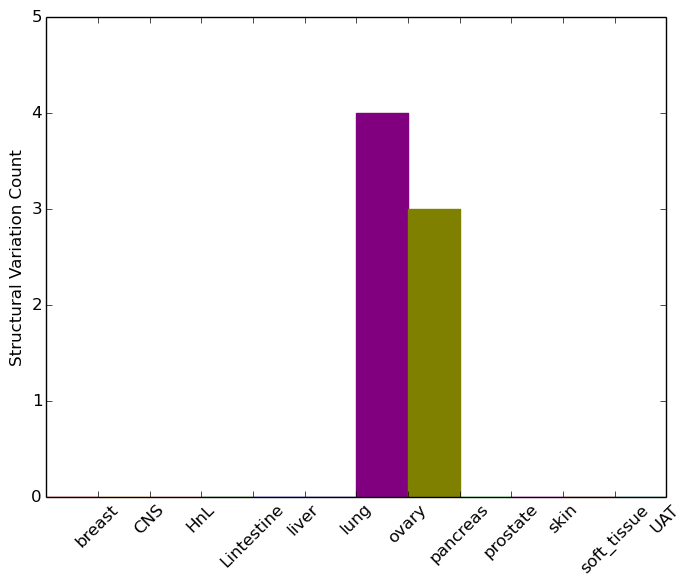 |
| - For Intra-chromosomal Variations |
| * Intra-chromosomal variantions includes 'intrachromosomal amplicon to amplicon', 'intrachromosomal amplicon to non-amplified dna', 'intrachromosomal deletion', 'intrachromosomal fold-back inversion', 'intrachromosomal inversion', 'intrachromosomal tandem duplication', 'Intrachromosomal unknown type', 'intrachromosomal with inverted orientation', 'intrachromosomal with non-inverted orientation'. |
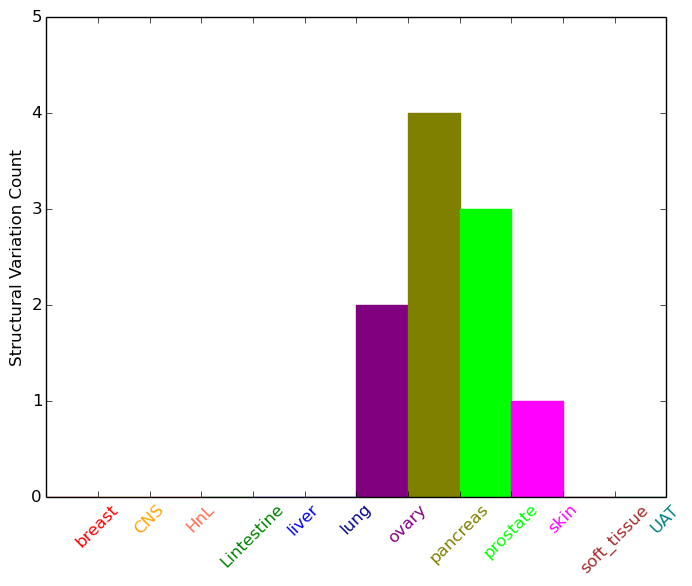 |
| Sample | Symbol_a | Chr_a | Start_a | End_a | Symbol_b | Chr_b | Start_b | End_b |
| ovary | GALNTL6 | chr4 | 173360321 | 173360341 | ODZ3 | chr4 | 183552344 | 183552364 |
| pancreas | GALNTL6 | chr4 | 172826170 | 172826370 | TMEM117 | chr12 | 44302122 | 44302322 |
| pancreas | GALNTL6 | chr4 | 173159682 | 173159702 | RWDD4 | chr4 | 184577119 | 184577139 |
| pancreas | GALNTL6 | chr4 | 173332792 | 173332812 | GALNTL6 | chr4 | 173332843 | 173332863 |
| pancreas | GALNTL6 | chr4 | 173476128 | 173476148 | GALNTL6 | chr4 | 173446207 | 173446227 |
| pancreas | GALNTL6 | chr4 | 173515480 | 173515500 | chr11 | 127818586 | 127818606 | |
| pancreas | GALNTL6 | chr4 | 173723968 | 173723988 | GALNTL6 | chr4 | 173833423 | 173833443 |
| prostate | GALNTL6 | chr4 | 173233547 | 173233547 | GALNTL6 | chr4 | 173539655 | 173539655 |
| skin | GALNTL6 | chr4 | 173631903 | 173631903 | GALNTL6 | chr4 | 173632747 | 173632747 |
| cf) Tissue number; Tissue name (1;Breast, 2;Central_nervous_system, 3;Haematopoietic_and_lymphoid_tissue, 4;Large_intestine, 5;Liver, 6;Lung, 7;Ovary, 8;Pancreas, 9;Prostate, 10;Skin, 11;Soft_tissue, 12;Upper_aerodigestive_tract) |
| * From mRNA Sanger sequences, Chitars2.0 arranged chimeric transcripts. This table shows GALNTL6 related fusion information. |
| ID | Head Gene | Tail Gene | Accession | Gene_a | qStart_a | qEnd_a | Chromosome_a | tStart_a | tEnd_a | Gene_a | qStart_a | qEnd_a | Chromosome_a | tStart_a | tEnd_a |
| Top |
| Mutation type/ Tissue ID | brca | cns | cerv | endome | haematopo | kidn | Lintest | liver | lung | ns | ovary | pancre | prost | skin | stoma | thyro | urina | |||
| Total # sample | 4 | 2 | 1 | 1 | 1 | 3 | 1 | 1 | 4 | |||||||||||
| GAIN (# sample) | 2 | 1 | 1 | 1 | 1 | 1 | ||||||||||||||
| LOSS (# sample) | 2 | 1 | 1 | 2 | 1 | 1 | 3 |
| cf) Tissue ID; Tissue type (1; Breast, 2; Central_nervous_system, 3; Cervix, 4; Endometrium, 5; Haematopoietic_and_lymphoid_tissue, 6; Kidney, 7; Large_intestine, 8; Liver, 9; Lung, 10; NS, 11; Ovary, 12; Pancreas, 13; Prostate, 14; Skin, 15; Stomach, 16; Thyroid, 17; Urinary_tract) |
| Top |
|
 |
| Top |
| Stat. for Non-Synonymous SNVs (# total SNVs=79) | (# total SNVs=22) |
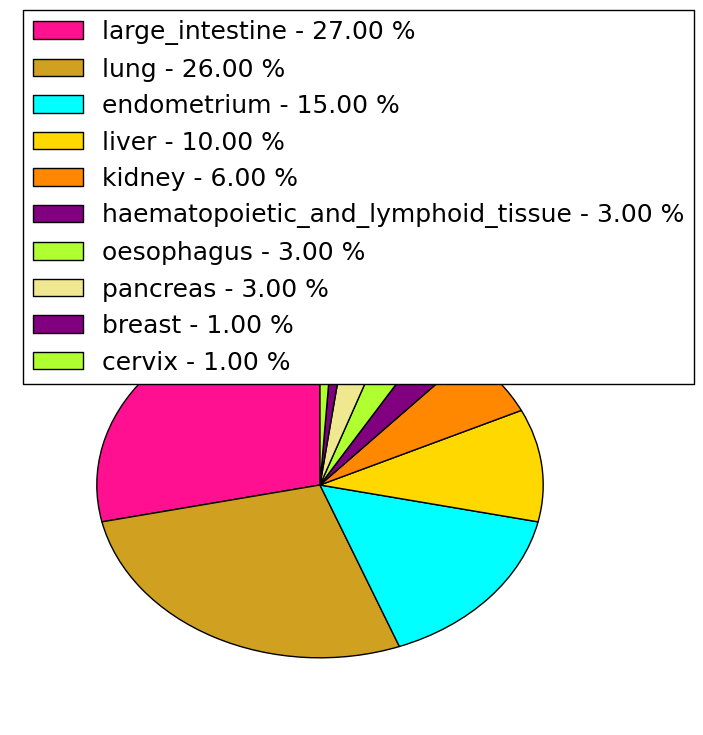 | 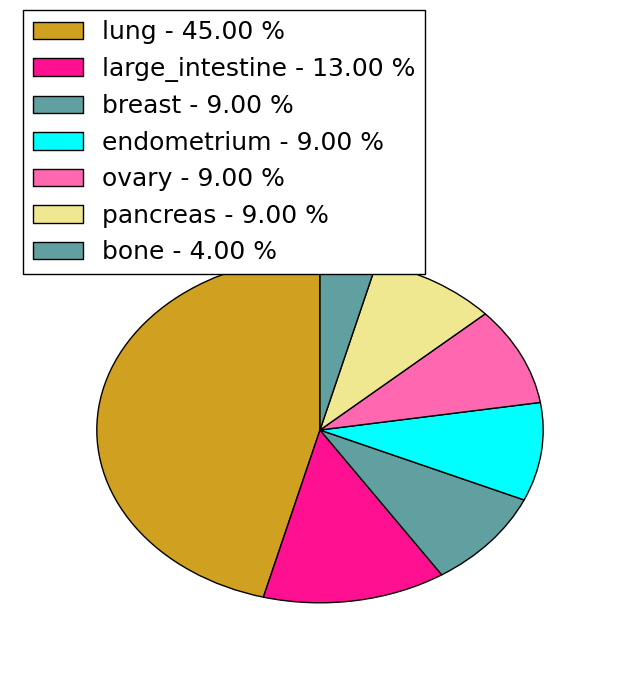 |
(# total SNVs=4) | (# total SNVs=0) |
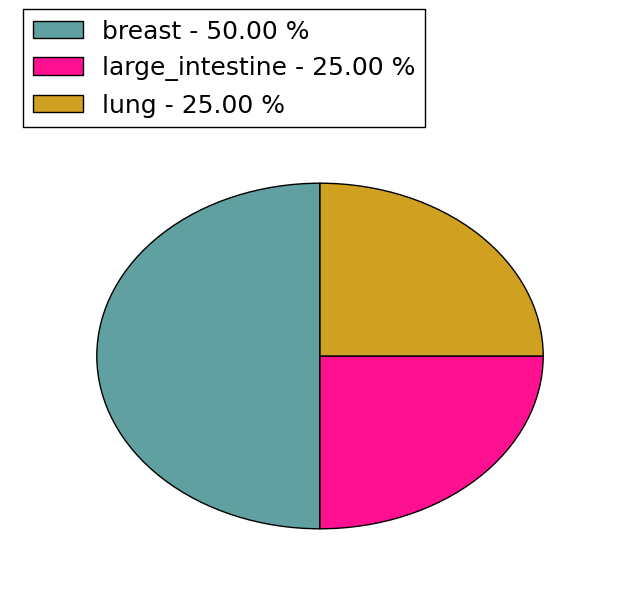 |
| Top |
| * When you move the cursor on each content, you can see more deailed mutation information on the Tooltip. Those are primary_site,primary_histology,mutation(aa),pubmedID. |
| GRCh37 position | Mutation(aa) | Unique sampleID count |
| chr4:173930333-173930333 | p.R459Q | 3 |
| chr4:173961139-173961141 | p.K567delK | 3 |
| chr4:173232893-173232893 | p.R126C | 3 |
| chr4:173269816-173269816 | p.L177I | 2 |
| chr4:173873377-173873377 | p.P447T | 2 |
| chr4:173232810-173232810 | p.H98R | 2 |
| chr4:172735787-172735787 | p.L19S | 2 |
| chr4:173269761-173269761 | p.R158R | 2 |
| chr4:173730571-173730571 | p.R205S | 2 |
| chr4:173730671-173730671 | p.N238S | 2 |
| Top |
|
 |
| Point Mutation/ Tissue ID | 1 | 2 | 3 | 4 | 5 | 6 | 7 | 8 | 9 | 10 | 11 | 12 | 13 | 14 | 15 | 16 | 17 | 18 | 19 | 20 |
| # sample | 4 | 2 | 2 | 13 | 5 | 1 | 1 | 1 | 17 | 5 | 1 | 17 | 12 | 11 | ||||||
| # mutation | 4 | 2 | 2 | 13 | 5 | 1 | 1 | 1 | 18 | 5 | 1 | 16 | 14 | 13 | ||||||
| nonsynonymous SNV | 3 | 1 | 12 | 5 | 1 | 1 | 1 | 12 | 4 | 12 | 12 | 11 | ||||||||
| synonymous SNV | 1 | 2 | 1 | 1 | 6 | 1 | 1 | 4 | 2 | 2 |
| cf) Tissue ID; Tissue type (1; BLCA[Bladder Urothelial Carcinoma], 2; BRCA[Breast invasive carcinoma], 3; CESC[Cervical squamous cell carcinoma and endocervical adenocarcinoma], 4; COAD[Colon adenocarcinoma], 5; GBM[Glioblastoma multiforme], 6; Glioma Low Grade, 7; HNSC[Head and Neck squamous cell carcinoma], 8; KICH[Kidney Chromophobe], 9; KIRC[Kidney renal clear cell carcinoma], 10; KIRP[Kidney renal papillary cell carcinoma], 11; LAML[Acute Myeloid Leukemia], 12; LUAD[Lung adenocarcinoma], 13; LUSC[Lung squamous cell carcinoma], 14; OV[Ovarian serous cystadenocarcinoma ], 15; PAAD[Pancreatic adenocarcinoma], 16; PRAD[Prostate adenocarcinoma], 17; SKCM[Skin Cutaneous Melanoma], 18:STAD[Stomach adenocarcinoma], 19:THCA[Thyroid carcinoma], 20:UCEC[Uterine Corpus Endometrial Carcinoma]) |
| Top |
| * We represented just top 10 SNVs. When you move the cursor on each content, you can see more deailed mutation information on the Tooltip. Those are primary_site, primary_histology, mutation(aa), pubmedID. |
| Genomic Position | Mutation(aa) | Unique sampleID count |
| chr4:173930333 | p.R459Q | 3 |
| chr4:173232893 | p.R403W | 2 |
| chr4:172735864 | p.M1V | 2 |
| chr4:173269816 | p.L64F | 2 |
| chr4:172735764 | p.L177I | 2 |
| chr4:173150860 | p.M11I | 2 |
| chr4:173852374 | p.P303R | 2 |
| chr4:173734859 | p.R126C | 2 |
| chr4:173873245 | p.P446L | 2 |
| chr4:172735732 | p.Q45E | 2 |
| * Copy number data were extracted from TCGA using R package TCGA-Assembler. The URLs of all public data files on TCGA DCC data server were gathered on Jan-05-2015. Function ProcessCNAData in TCGA-Assembler package was used to obtain gene-level copy number value which is calculated as the average copy number of the genomic region of a gene. |
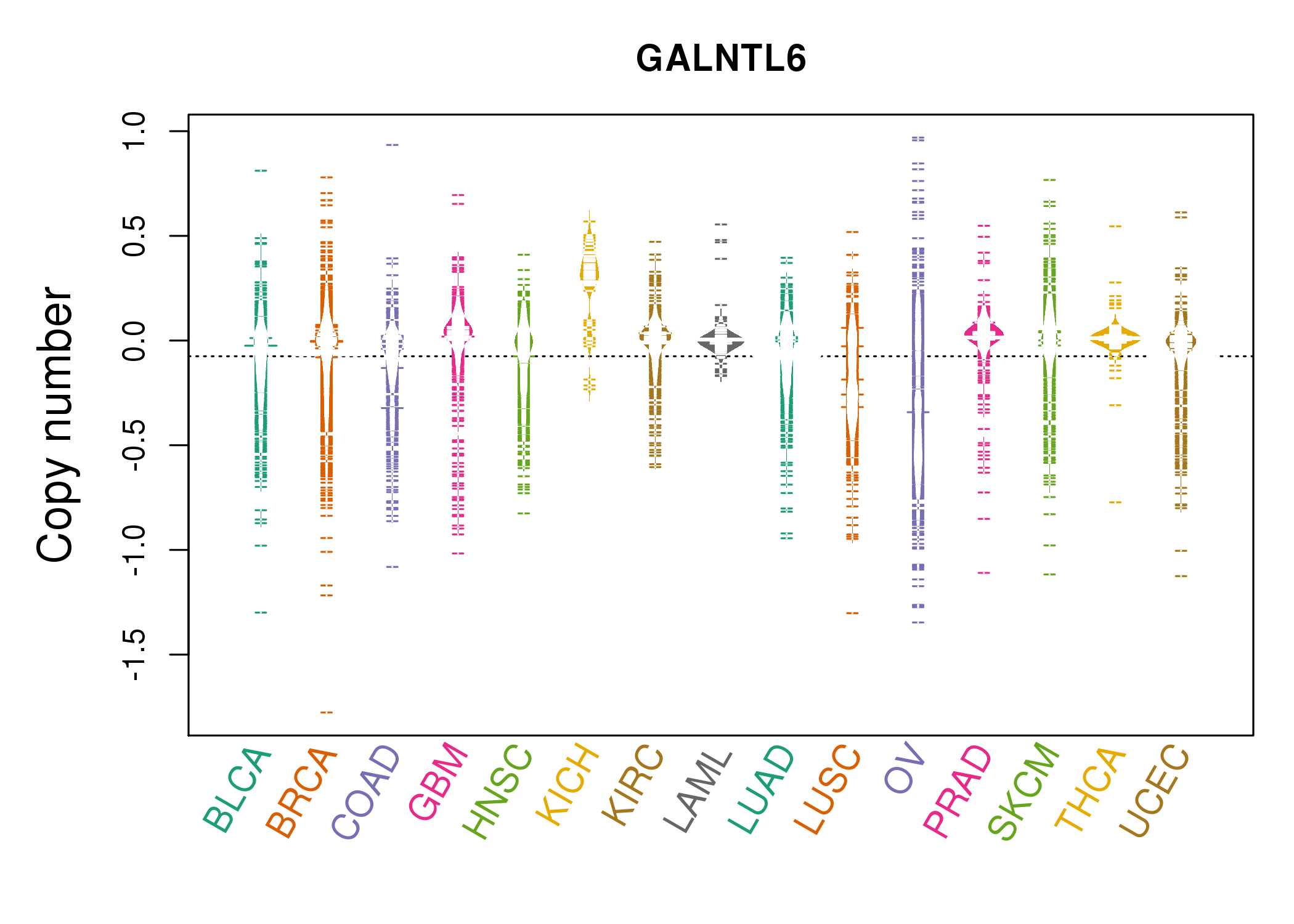 |
| cf) Tissue ID[Tissue type]: BLCA[Bladder Urothelial Carcinoma], BRCA[Breast invasive carcinoma], CESC[Cervical squamous cell carcinoma and endocervical adenocarcinoma], COAD[Colon adenocarcinoma], GBM[Glioblastoma multiforme], Glioma Low Grade, HNSC[Head and Neck squamous cell carcinoma], KICH[Kidney Chromophobe], KIRC[Kidney renal clear cell carcinoma], KIRP[Kidney renal papillary cell carcinoma], LAML[Acute Myeloid Leukemia], LUAD[Lung adenocarcinoma], LUSC[Lung squamous cell carcinoma], OV[Ovarian serous cystadenocarcinoma ], PAAD[Pancreatic adenocarcinoma], PRAD[Prostate adenocarcinoma], SKCM[Skin Cutaneous Melanoma], STAD[Stomach adenocarcinoma], THCA[Thyroid carcinoma], UCEC[Uterine Corpus Endometrial Carcinoma] |
| Top |
| Gene Expression for GALNTL6 |
| * CCLE gene expression data were extracted from CCLE_Expression_Entrez_2012-10-18.res: Gene-centric RMA-normalized mRNA expression data. |
 |
| * Normalized gene expression data of RNASeqV2 was extracted from TCGA using R package TCGA-Assembler. The URLs of all public data files on TCGA DCC data server were gathered at Jan-05-2015. Only eight cancer types have enough normal control samples for differential expression analysis. (t test, adjusted p<0.05 (using Benjamini-Hochberg FDR)) |
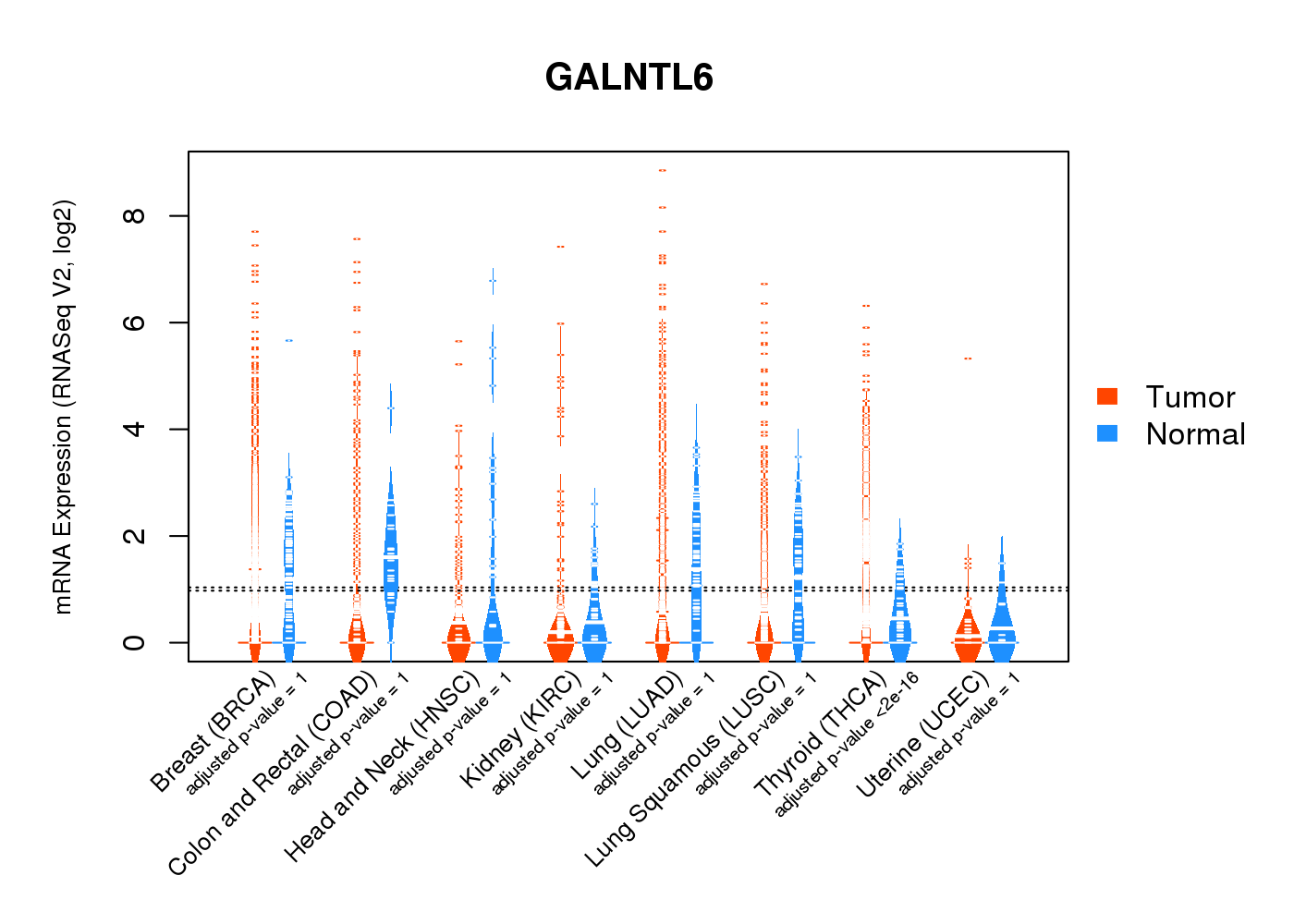 |
| Top |
| * This plots show the correlation between CNV and gene expression. |
: Open all plots for all cancer types
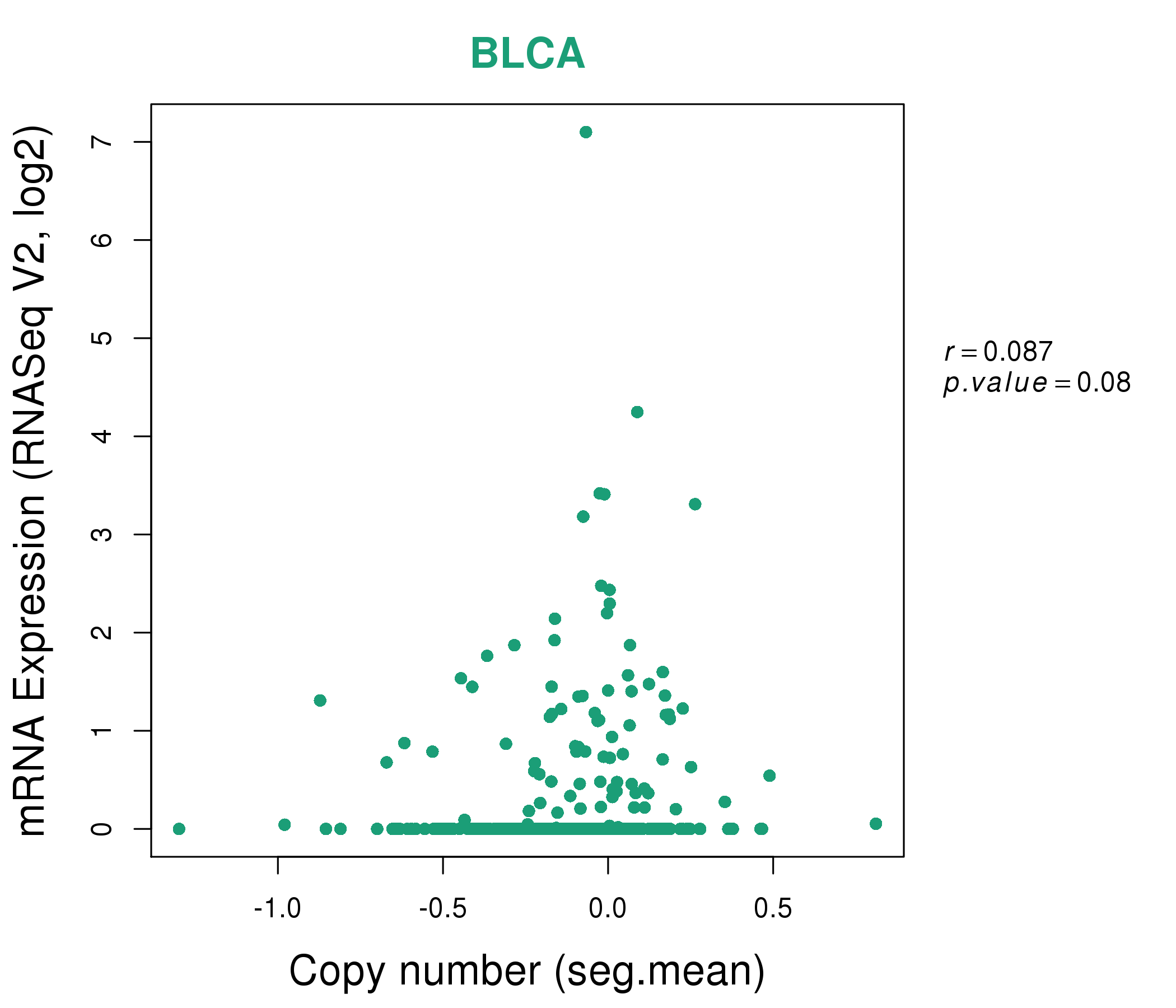 |
|
 |
|
| Top |
| Gene-Gene Network Information |
| * Co-Expression network figures were drawn using R package igraph. Only the top 20 genes with the highest correlations were shown. Red circle: input gene, orange circle: cell metabolism gene, sky circle: other gene |
: Open all plots for all cancer types
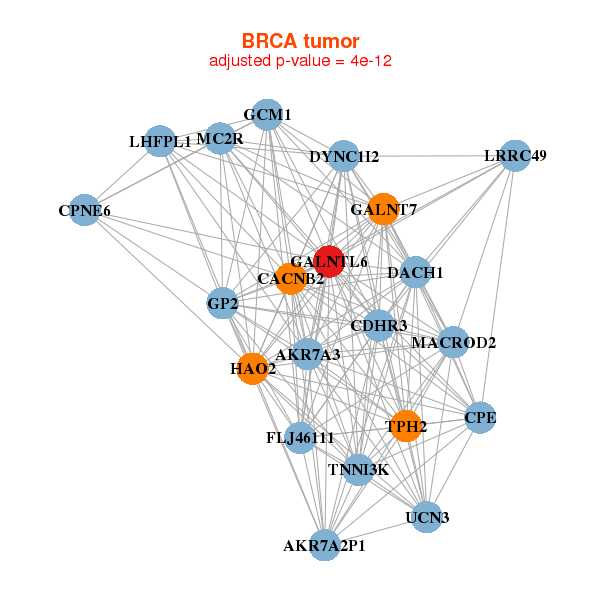 |
|
| AKR7A2P1,AKR7A3,CACNB2,CDHR3,CPE,CPNE6,DACH1, DYNC1I2,FLJ46111,GALNT7,GALNTL6,GCM1,GP2,HAO2, LHFPL1,LRRC49,MACROD2,MC2R,TNNI3K,TPH2,UCN3 | ASCL2,C11orf85,C2orf50,C2orf54,CPA6,CSMD3,CYP4F2, GALNTL6,GLYATL3,KCNF1,KRTAP10-10,LHX1,MCHR1,NTSR1, PRSS1,SLC7A13,SPANXA2,SPANXC,SPANXD,ABHD11-AS1,WNT3A |
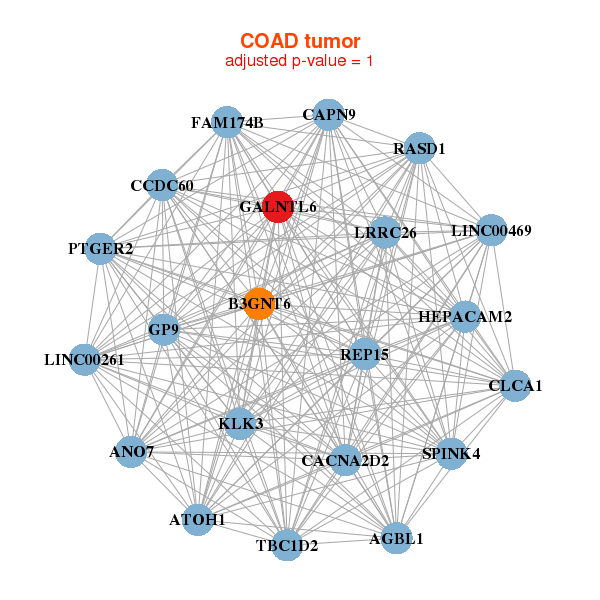 |
|
| AGBL1,ANO7,ATOH1,B3GNT6,LINC00469,LINC00261,CACNA2D2, CAPN9,CCDC60,CLCA1,FAM174B,GALNTL6,GP9,HEPACAM2, KLK3,LRRC26,PTGER2,RASD1,REP15,SPINK4,TBC1D2 | BPIFB4,CD300LG,CNBD1,CST11,DEFB124,DPYS,DYDC1, GALNTL6,GLYCAM1,HPN,LIM2,LOC55908,MARCO,NKX6-2, OR3A4P,REG1A,REG1B,SBSN,SCGB1A1,SCGB3A1,SNORA22 |
| * Co-Expression network figures were drawn using R package igraph. Only the top 20 genes with the highest correlations were shown. Red circle: input gene, orange circle: cell metabolism gene, sky circle: other gene |
: Open all plots for all cancer types
| Top |
: Open all interacting genes' information including KEGG pathway for all interacting genes from DAVID
| Top |
| Pharmacological Information for GALNTL6 |
| There's no related Drug. |
| Top |
| Cross referenced IDs for GALNTL6 |
| * We obtained these cross-references from Uniprot database. It covers 150 different DBs, 18 categories. http://www.uniprot.org/help/cross_references_section |
: Open all cross reference information
|
Copyright © 2016-Present - The Univsersity of Texas Health Science Center at Houston @ |






